A Primer on Combat Aircraft
More than for any other type of weaponry, aircraft technology has made quantum leaps since the first biplanes flew over the battlefields of France and Flanders in World War I. World War II saw a further expansion of the roles which aircraft could perform, with missions such as maritime patrol and night combat becoming just as necessary as traditional roles like bombing and reconnaissance. Today, many aircraft are multi-role, and can be armed with a wide variety of precision munitions and missiles. The designation applied on this site is also included in parenthesis.
World War II Fighters
Fighter (F): The classic fighter has been in existence since World War I, and this designation refers to all aircraft whose primary mission is to seek and destroy enemy aircraft. In their early days, most fighters were slow but nimble bi- or tri-planes, but monoplanes gradually became the norm in fighter design in the late 1930s. Jet fighters were introduced late in World War II, with Luftwaffe's Me 262 being the first to enter service, followed just days later by the RAF's Meteor (jet-to-jet combat, however, would have to wait until the Korean War). Note that this site makes no distinction between carrier-borne fighters and land-based fighters, given that all carrier-borne aircraft can (and frequently do) operate from land bases. Aviation experts have grouped jet fighters into five separate generations, plus one intermediate generation, which are described as follows (note that these include fighter-bombers and multi-role fighters which are classified separately):
Fighter-Bomber (FB): A fighter with an attack role, usually for close support missions over the battlefield. Although most fighters from World War II onward have had some bombing capability, fighter-bombers were those designs which could perform the role as well as a dedicated ground attacker. In some cases like the P-40 and P-47 (US) and the Typhoon (UK), they began their careers as fighters but gradually dedicated themselves to ground attack once newer fighters entered service. Others like the Fw 190F (Germany) were dedicated variants of an original fighter design. And some like the post-war F-4 (US) performed both roles equally. Compared to fighter/attack aircraft (see below), fighter-bombers mostly rely on free-fall bombs and rockets, rather than missiles, as their primary armament.
Heavy Fighter (HF): During World War II there was an interest in designing large, twin-engine fighters that could be used as bomber escorts as well as other roles. This was exemplified in the Zerstörer concept behind the Luftwaffe's Bf 110 which was tremendously effective during the Blitzkrieg campaigns. However, heavy fighters proved to be highly vulnerable to smaller, faster single-engine fighters and as a result, many heavy fighter designs were converted for other uses such as ground attack and night fighters, which they proved well suited for.
Night Fighter (NF): Night combat was among the most sophisticated undertaken during World War II, where many advances such as radar vectoring were pioneered. Radars were occasionally added to day fighters in order to provide them with night-time capability, but more success was obtained through the conversion of multi-engined heavy fighters or light/medium bombers like the Bf 110, Ju 88 (Germany) and Mosquito (UK). As radars became smaller in the post-war era, the specialized night fighter quickly became obsolete as day fighters gained all-weather capability.
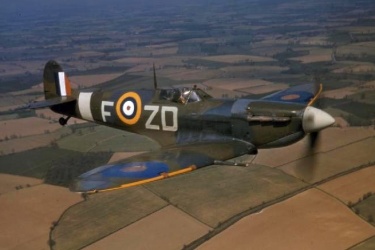 |
Probably the most iconic fighter of World War II, the Supermarine Spitfire was one of the few aircraft that fought during the entirety of the conflict. Its large, elliptical wings gave it a turning ability that few other Axis or Allied fighters could match. |
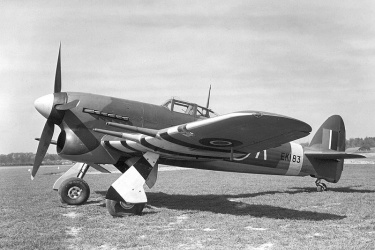 |
Armed with bombs and rockets, the Hawker Typhoon was one of the best Allied fighter-bombers of World War II. In Normandy, 'cab ranks' of Typhoons flying behind the lines would be directed by ground troops onto German formations with devastating effect. |
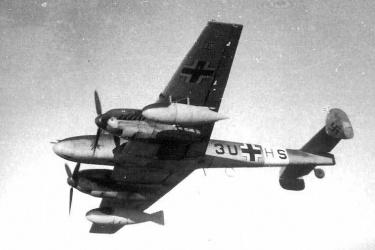 |
The heavy fighter concept, as exemplified by this Messerschmitt Bf 110 was through to be groundbreaking at the start of the war, but their powerful armament could not make up for their lack of speed and maneuverability compared to single-engined fighters. |
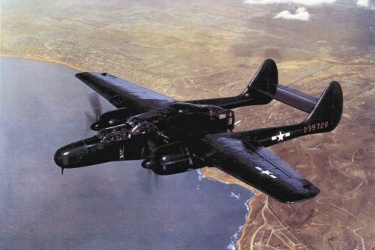 |
Night fighters like this P-61 Black Widow borrowed the design of heavy fighters but were equipped with radar and other technologies making them among the most sophisticated aircraft of World War II. Advances in all-weather capability made them largely obsolete in the post-war era. |
Modern Fighters
Jet Fighter (F): The introduction of jet fighters in 1944 revolutionized air combat, as they could achieve speeds that even the best piston-engined aircraft couldn't match. Military aviation experts and enthusiasts have described the evolution of jet fighters through a series of generations which are summarized below, followed by other categories of fighter aircraft which are in use today.
- 1st Generation (1945): These represent the initial jet designs that emerged in World War II and up until the Korean War. Many of these aircraft were designed with swept-wings that were more efficient at higher speeds, though there were still numerous aircraft that had straight wings. Despite these advances, air combat tactics were mostly unchanged from World War II, as was armament (guns, bombs, and rockets). The Korean War rivalry between the F-86 (US) and the MiG-15 (USSR) represents the epitome of 1st Generation fighter design, with other notable aircraft during this period being the F9F (US) and Hunter (UK).
- 2nd Generation (~1955): This was the first supersonic generation, and many of these aircraft would also be equipped with radar and air-to-air missiles. Despite this, both radar and missiles were rather primitive and as a result, combat still revolved around guns and other conventional armament. The delta-wing became popular among this generation of fighters. Notable 2nd generation aircraft included the Mirage III (France), Draken (Sweden), F-8, F-100, F-104 (US), MiG-19, and MiG-21 (USSR) some of which saw combat during the first part of the Vietnam War.
- 3rd Generation (~1965): The third generation was considerably faster than their predecessors, with many designs exceeding the Mach 2 threshold. By now, radars had become a necessity and were sophisticated enough to allow all-weather operation. Furthermore, most aircraft were designed with ground-attack capability in mind and could be equipped with air-to-surface and anti-ship missiles. However, the most notable change was the use of air-to-air missiles as the primary armament for air combat; so much that one of the most iconic aircraft of this era, the F-4 Phantom was initially designed without guns. Other representative aircraft include the Mirage F.1 (France), Viggen (Sweden), and MiG-23 (USSR), many of which saw combat in conflicts during the 1970s and 80s.
- 4th Generation (~1975): The 4th generation put dogfighting as a priority again, compared to the preference for missile platforms of the previous generation. Other changes included the first glass cockpits which replaced old analogue instruments with multi-function displays. Fly-by-wire systems were also introduced as well as multi-mode radars which made many of these aircraft true multi-role platforms. US and Coalition 4th generation aircraft proved their worth during the first Gulf War and have demonstrated incredible longevity; most of these same aircraft remain in active service and will remain so well into the 21st century. Major designs include the Mirage 2000 (France), MiG-29 and Su-27 (USSR), and the US 'teen series' (F-14, F-15, F-16, F/A-18).
- 4.5 Generation (~1995): This is an interim generation that is based on 4th generation airframes but with further design and avionics improvements such as reduced radar cross-sections (though not purely stealth), super-cruise, and AESA radars. There was a preference for canard-equipped delta wings, as seen in the Gripen (Sweden), Rafale (France), and Eurofighter Typhoon (UK/Germany/Italy/Spain). Some 4.5 generation aircraft were developed from 4th generation predecessors, such as the F/A-18E/F (US) as well as the Su-30 and Su-35 (Russia).
- 5th Generation (~2005): 5th generation aircraft are the most advanced in the world today, incorporating most of the advances of the 4.5 generation but fully stealth. There is also emphasis on pilot situational awareness, and the use of helmet-mounted displays coupled with off-boresight air-to-air missiles. The US was the first to field a true 5th generation fighter, the F-22, although China and Russia have now added the J-20 and Su-57 to their arsenals.
Fighter/Attack (FG): Fighter/attack aircraft or 'strike fighters' refers to the World War II-era concept of torpedo fighters; essentially torpedo bombers with air combat capability. The term is now used for fighters whose armament is primarily stand-off missiles, as well as attack aircraft that have considerable air-to-air capability like the F-15E (US) or Su-34 (Russia), usually because they are based on a fighter design. Although most modern attack aircraft can carry air-to-air weaponry as defensive aids, fighter/attack aircraft could hold their own against enemy fighters if challenged.
Multi-Role Fighter (FGR): Multi-role fighters are aircraft that can fulfill at least three separate roles, these typically being air defense/interception, ground attack, and reconnaissance. These fighters are typically found among the 4th generation given the advent of multi-mode radars that allow them to perform these separate roles often in the same sortie. Except for pure air superiority designs like the F-15 and Su-27, almost all fighters conceived since the 1980s are multi-role.
Interceptor (I): Interceptors are large, fighter-like aircraft designed primarily to shoot down enemy bombers. They are the heirs to World War II-era heavy fighters and night fighters once radars could be made small enough for tactical aircraft to have all-weather capability. Interceptors typically feature more powerful engines designed for greater speed (up to Mach 2-3) and higher service ceilings, while their size allows them to operate more effectively as platforms for long-range missiles. They are less agile than fighters, however, and not strictly designed for dogfighting though there are exceptions like the F-14 (US). They also typically lack ground-attack capability. Other examples include the Lightning (UK), F-106 (US), MiG-25, and MiG-31 (USSR), the latter which is the world's largest tactical aircraft and also the sole interceptor still in service.
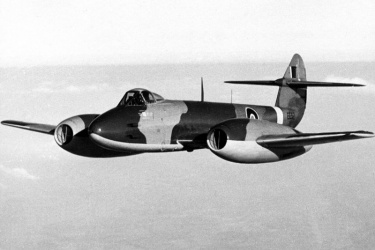 |
The Gloster Meteor was the first British (and Allied) jet fighter to enter service, just a few months after Germany's own, though it was mostly used to hunt V-1 flying bombs. Nevertheless, it had a long post-war service life including combat in Korea and Suez. |
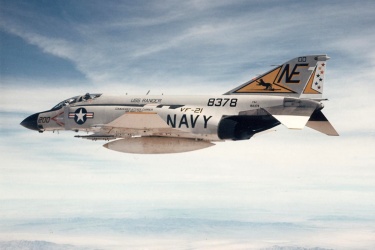 |
Undoubedly one of the best US aircraft of the Cold War, the McDonnell-Douglas F-4 was the quintessential third-generation fighter and served with most major NATO air forces as well. It was also very effective as a fighter-bomber, shouldering the bulk of tactical bombing operations in the Vietnam War. |
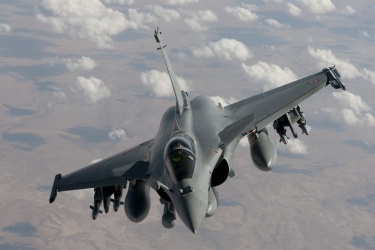 |
The 4.5 generation Dassault Rafale is the most advanced French fighter currently in service. It is a true multi-role design, being able to fulfill the air superiority role as well as be an incredibly effective ground attacker, even in the same mission. |
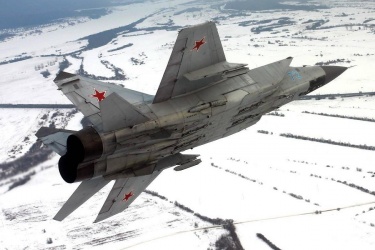 |
Interceptors like the Mikoyan MiG-31 are rare nowadays but were the first line of defense against enemy bombers during the Cold War. They are larger and usually not as maneuverable as fighters but have powerful radars and carry the largest air-to-air missiles available. |
Bombers
Bomber (B): Bombers are aircraft designed for tactical or strategic attacks behind enemy lines. They may operate at low level, where they are more difficult to detect, or at high altitude where they may exceed the maximum ceilings of some enemy fighters or anti-air defenses. A key distinction with other attack aircraft is that bombers are traditionally employed for level bombing, as opposed to dive bombing or strike. Bombers are generally defined by their size or role and consequently, the generic 'bomber' designation is rarely used on this site, except in some cases where the aircraft do not fit in a more specific classification. Some examples include smaller nuclear bombers like the B-45 and B-58 (US) whose reduced size and range gave them limited strategic capabilities.
Medium Bomber (MB): The medium bomber was the most widely employed bomber design during World War II, with all major combatants fielding numerous such designs. Medium bombers were almost always twin-engine (save for numerous three-engine Italian designs like the iconic SM.79) and could carry payloads of around 1-2,000 kg at medium or long ranges. Medium bombers were highly versatile and could perform both tactical and strategic operations. For air forces that fielded large numbers of heavy bombers (namely the RAF and USAAF), the mediums were mostly used for tactical roles or in theaters where heavy bombers were less needed such as the Mediterranean. After World War II, medium bombers largely disappeared given that smaller attack aircraft could fill the same roles. Notable examples include the Hampden and Wellington (UK) which were the mainstays of RAF Bomber Command before the heavies entered service in large numbers, the B-25 and B-26 (US), and the He 111, Ju 88, and Do 217 (Germany), the latter which was among the first aircraft capable of carrying air-to-ground missiles. Note that Japan usually referred to its medium bombers as 'heavy' bombers.
Heavy Bomber (HB): These were the largest bombers in use during World War II. Their sophistication of design and operation was such that only two air forces, the RAF and USAAF, employed them in large numbers although most combatants had at least one heavy bomber design in limited use. Heavy bombers were usually capable of carrying large payloads of at least 4,000 kg at long ranges, with their main objectives being area attacks against cities, or against strategic targets like factories and oil refineries. They also carried formidable defensive armament, in the case of USAAF day bombers like the B-17 and B-24 with as many as 10 guns or more. RAF heavies used for night bombing like the Halifax and Lancaster were also the first to use ground mapping radars like the H2S which made them even more accurate than their their day bomber counterparts. World War II-era heavy bombers could carry some of the heaviest bombs ever dropped such as the 22,000-lb 'Grand Slam' bomb and also the first nuclear bombs. After World War II, heavy bombers became the primary nuclear delivery vehicles and as such, became known as strategic bombers.
Strategic Bomber (SB): The direct descendants of the heavy bomber for the jet and nuclear eras. Their primary role is to undertake nuclear attacks deep into enemy territory, either with free-fall bombs or later, with nuclear-armed cruise missiles which allowed them to strike well outside the range of enemy interceptors. Larger strategic bombers like the B-52 (US) and Tu-95 (USSR) had intercontinental range and even in peacetime would fly provocatively close to the enemy heartlands in order to probe their defenses. Others like the Tu-22M (USSR) were used for nuclear or conventional anti-ship strikes against NATO carrier battle groups. The end of the Cold War devalued the strategic bomber's primary nuclear role and as a result, many were quickly readapted for conventional bombing including with precision weaponry. A single B-1B (US) bomber, for example, can carry up to 48 JDAM bombs. Currently, only the US and Russia field modern strategic bombers.
Light Bomber (LB): The light bomber fills the space between a ground attack aircraft and a medium bomber. Most World War II light bombers were single-engine or (more commonly) twin-engine aircraft designed for tactical operations. They had less protection than medium bombers and generally relied on speed and/or maneuverability rather than firepower to evade enemy fighters; an extreme case was the RAF Mosquito which had no defensive armament altogether. Despite this, many had formidable bombing capability. For example, the A-26 (US) could carry a bigger payload than the B-25 or B-26, and the Mosquito could also carry as much as a Stirling heavy bomber at the extreme end of its range. Some light bombers continued to be built after the war, though like medium bombers, the role was mostly taken over by smaller attack aircraft.
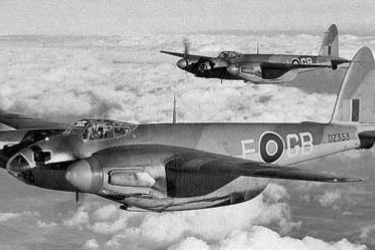 |
The de Havilland Mosquito was a fantastic World War II light bomber made almost entirely of wood. It was as fast as a fighter and could carry a payload all the way to Berlin that was nearly as large as a heavy bomber. |
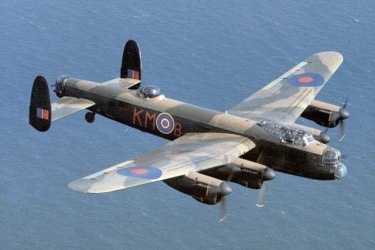 |
The Avro Lancaster was the RAF's main heavy bomber of World War II, and helped pioneer countless bombing technologies including radar and electronic countermeasures. Despite operating mostly at night, it was more accurate than the USAAF's day bombers. |
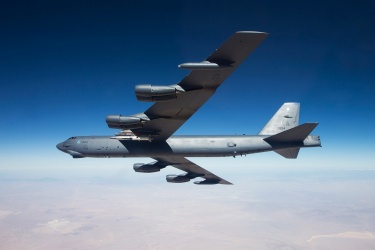 |
Strategic jet bombers like the B-52 Stratofortress are the 'heavies' of the nuclear age and can carry a payload that dwarfs that of any World War II bomber, including both conventional and nuclear weapons. Thankfully for humanity, they have only dropped the former in anger. |
Attack
Attack (GR): The attack aircraft is a fighter-sized aircraft designed for ground or maritime attack. They are often referred to as tactical bombers. Attack aircraft largely replaced all types of non-strategic bombers over the course of the Cold War as they became ever more versatile and capable of carrying sophisticated weaponry such as precision munitions and air-to-surface missiles. Modern attack aircraft include the F-111 (US), Tornado (UK/Germany/Italy), and Su-24 (USSR), while those used for close support include the A-10 (US) and Su-25 (US). Carrier-borne attack aircraft include the AD/A-1 and A-6 (US). Note that modern attack aircraft with air combat capability are classified as fighter/attack aircraft.
Close Support (A): These are ground attack aircraft primarily designed for close battlefield support, rather than tactical bombing behind enemy lines. This encompasses a wide variety of aircraft, such as the Il-2 Sturmovik (Russia) which was the most widely produced combat aircraft of all time but also some twin-engine aircraft like the Hs 129 (Germany) tank-killer. Modern examples like the A-10 (US) and Su-25 (USSR) are extremely rugged and are optimized for low-altitude loitering rather than stand-off attacks from higher altitudes.
Dive Bomber (DB): Dive bombers were aircraft designed with special brakes that allowed them to undertake a steep dive in order to attack their targets. This gave them considerably better accuracy than level bombers, particularly against moving targets like tanks. Some dive bombers like the infamous German Ju 87 Stuka (arguably the most representative aircraft of the Blitzkrieg) could dive at virtually a 90-degree angle. Dive bombers were particularly suitable for naval attack and some of the most famous designs like the SBD Dauntless (US) and D3A 'Val' (Japan) were carrier-based. Dive bombers largely disappeared after World War II as naval attack aircraft became more accurate in level attacks.
Light Attack (LA): Light attack aircraft are typically trainers with some degree of combat capability, though generally with smaller payloads and less sophisticated weaponry than dedicated attack aircraft. They were particularly attractive for smaller air forces which could tick two boxes with a single aircraft. Notable designs include the Hawk (UK) which has been one of the most widely exported British aircraft of the post-war era, as well as the Alpha Jet (France/Germany) and MB.326 (Italy),
Counter-Insurgency (COIN): During the Cold War, the frequency of colonial and guerrilla wars demonstrated the need for smaller, cheaper attack aircraft that could be used specifically for smaller-scale conflicts. This resulted in designs like the A-37 (US) and Strikemaster (UK), the former which was based on a civilian light transport and the latter on a trainer. Their slower speed (many are turboprops) is particularly advantageous for low-level operations in low-threat environments. For third-world countries, COIN aircraft proved to be highly popular given their more accessible price tags and remain in widespread use today. Countries will less-sophisticated aircraft industries have also designed COIN aircraft like the Tucano (Brazil) and Pucará (Argentina).
Gunship (AC): Gunships are specially-modified transports with formidable armament in the form of machine guns, cannon, mini-guns and in some cases, even howitzers. Gunships are used primarily for close support in day or night, where their longer endurance gives them an advantage compared to normal ground attack aircraft. The gunship designation in this site is used exclusively for these types of aircraft such as the AC-130 (US), rather than World War II era gunships which were more heavily armed versions of light/medium bombers.
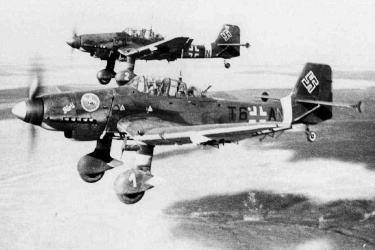 |
Few World War II aircraft were as feared as the Ju 87 Stuka dive bomber, which was one of the key components of the German blitzkrieg. Dive bombers were also used extensively in the carrier battles of the Pacific but this method of bombing largely fell out of favor in the jet age. |
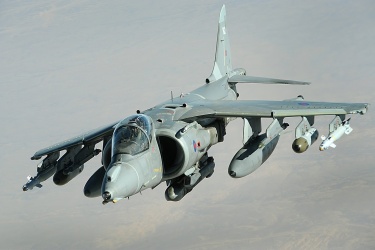 |
The Hawker Siddeley Harrier was a revolutionary aircraft that had the ability to take off and land vertically. It was designed to fly from any open field in Europe and provide close support to troops on the front lines. It is also used by the US Marines to provide close support to its amphibious assault units. |
.jpg) |
The British-German-Italian Tornado is not only one of the most successful multinational collaborations in aviation history, it also produced one of the finest attack aircraft, which performed stupendously in the Gulf War performing missions that no US aircraft could have pulled off so well. |
Maritime
Maritime Patrol (P): The maritime patrol role emerged during the inter-war years as aircraft became ideal for use as long-range eyes to the battle fleets. Initially, flying boats were ideal for this role thanks to their huge endurances and ability to be refueled at sea; some of the most famous World War II flying boats included the PBY Catalina (US), H8K 'Emily' (Japan), and Sunderland (UK). These were gradually superseded by long-range aircraft like the Fw 200 (Germany) and the B-24 (US), the latter which played a huge role in plugging the gaps in the Atlantic where U-Boats could roam free from air attack. The growing threat of submarines during the post-war period turned most maritime patrol aircraft into dedicated sub-hunters, armed with sophisticated electronic equipment such as sonobuoys and magnetic-anomaly detectors. Modern designs like the P-3 (US), Nimrod (UK), and Il-38 (USSR) could also carry a wide variety of weapon including anti-ship missiles, torpedoes, and mines.
Torpedo Bomber (TB): Torpedo bombers complemented dive bombers as the two main types of naval attack aircraft during World War II, but many were land-based designs similar in shape and performance to light bombers with torpedoes replacing bombs as their primary armament. Some of the most notable designs included the TBF Avenger (US) and B5N 'Kate' (Japan) which fought in all major naval battles in the Pacific. Like dive bombers, they became obsolete after the war in favor of maritime strike and attack aircraft which could carry a wider array of weapons besides torpedoes.
Maritime Strike (MS): These are carrier- or land-based aircraft which are explicitly dedicated for attacks against surface ships. During World War II, these were mostly land-based conversions of heavy fighters or light bombers like the Beaufighter TF.X (UK), which could employ a variety of armament like rockets and torpedoes (those which were based entirely around torpedoes are simply called torpedo bombers). In the post-war era, these included purpose-built aircraft like the Buccaneer (UK) which was originally designed to combat Soviet cruisers. This designation is largely obsolete given that anti-ship missiles are now carried by most attack aircraft, and remaining maritime strike aircraft like the Super Étendard (France) evolved into a land-attack role.
Anti-Submarine (S): The majority of maritime patrol aircraft have anti-submarine warfare as their primary missions, but carrier-borne ASW aircraft have also been designed in order to provide the carrier battle groups with similar capabilities while at sea. Being smaller than their land-based counterparts, they have shorter endurance but carry similar electronic equipment and weapons. Although aircraft like the S-3 (US) remain in service, the dedicated ASW role is now mostly undertaken by helicopters.
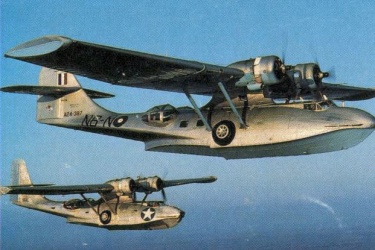 |
Flying boats like the Consolidated PBY Catalina were some of the main platforms for maritime patrol in World War II where their endurance would allow them to cover the vast distances of the Atlantic and Pacific. Converted bombers like the B-24 were also very effective in this role. |
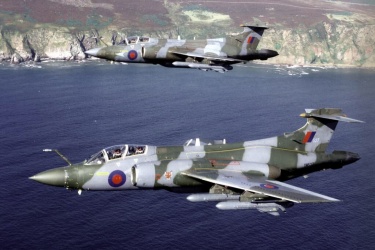 |
The Blackburn Buccaneer was one of the best low-altitute attack aircraft of all time, designed to hunt Soviet cruisers and other surface ships. Following the demise of Britain's conventional carrier fleet in the 1970s it was picked up by the RAF as a land-based attacker. |
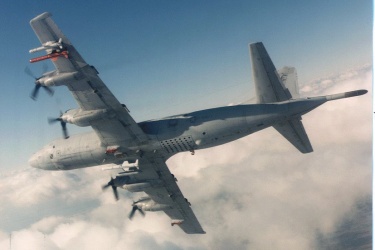 |
Modern patrol aircraft like the P-3 Orion use sophisticated sensors such as sonobuoys and magnetic anomaly detectors to hunt submarines. They have massive endurance to cover large stretches of ocean and can be armed with depth charges, torpedoes, mines, and anti-ship missiles. |
Reconnaissance / Electronic Warfare
Reconnaissance (R): The basic reconnaissance classification is used on this site mainly for tactical recon aircraft using photographic equipment (hence also referred to as photo-recon aircraft). Many were conversions or variants of combat designs including popular fighters like the P-38/F-5 and P-51/F-8 (US), or larger aircraft like the PR variants of the Mosquito (UK) whose speed and ceiling made them ideal for the photo-recon role. Some like the outstanding Ki-46 'Dinah' (Japan), however, were purpose-built designs. The advent of jet engines allowed tactical recon aircraft to fly even higher and faster than many jet fighters, and were also increasingly equipped with more sophisticated electronic equipment. A few that were converted from bombers or attack aircraft retained limited bombing capability as well. The tactical recon role is now increasingly employed by UAVs which have longer endurance than manned aircraft.
Strategic Reconnaissance (SR): The need to employ longer ranged spy aircraft to operate deep into enemy territory at altitudes where they could not be detected or intercepted resulted in the creation of the first strategic reconnaissance aircraft. These included aircraft such as the infamous U-2 (US) whose shooting down inside the USSR in 1960 led to a major diplomatic embarrassment. Others like the SR-71 (US) are among the fastest aircraft ever designed, reaching speeds in excess of Mach 3. The end of the Cold War put an end to new strategic recon designs, though new hypersonic UAVs are on the drawing board.
Electronic Intelligence (ER): Also known a ELINT, electronic intelligence aircraft are designed to snoop for enemy electronic transmissions from radars, missiles, or other aircraft. Like other recon aircraft, most are variants of other combat types though the majority do not have combat capability themselves.
Electronic Warfare (EW): These are aircraft designed to use electronic counter-measures (ECM) for offensive or defensive purposes. This mostly involves the use of powerful jammers designed to disrupt enemy radars and other electronic equipment. Electronic warfare aircraft are typically employed in the support role though many have combat capabilities themselves, such as the ability to use anti-radiation missiles. Note that aircraft employed in the suppression of enemy air defense (SEAD) role are included under attack aircraft given that ECM is not their main role.
Airborne Early Warning (AEW): Also known as Airborne Warning and Control Systems (AWACS), AEW aircraft are designed around powerful radars that can scan the airspace and direct fighters and other combat aircraft to their airborne targets. AEW aircraft like the E-3 (US) have been vital in giving NATO air forces a major advantage in combat against non-AEW equipped rivals, notably in the Gulf War where they were first used on a large scale. Other aircraft like the E-8 (US) perform as similar role albeit for ground targets.
Observation (O): These were small reconnaissance aircraft designed for battlefield observation roles such as artillery spotting during World War II. Their naval counterparts (usually flying boat designs) fulfilled similar missions for big-gun surface ships like battleships and cruisers. The role was among the first to be undertaken by helicopters, which quickly replaced fixed-winged aircraft after World War II.
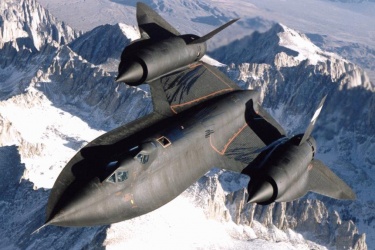 |
The SR-71 Blackbird was a Cold War era strategic reconnaissance aircraft that was able to fly higher and faster than anything that could potentially shoot it down. Capable of speeds over Mach 3, it is still the fastest manned aircraft to every take to the sky. |
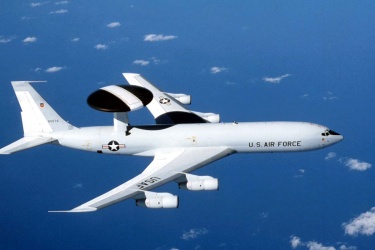 |
AWACS aircraft like the E-3 Sentry are the eyes of the US and NATO air forces, capable of using their powerful radar to map the aerial battlefield and vector friendly fighters towards their targets. They are among the most valuable air assets an air force can have. |
Transports / Tankers
Transport (C): A military transport plane is designed to airlift troops and cargo into combat areas. Most early designs were conversions of civilian airliners such as the C-47 (US) and Ju 52 (Germany) which were iconic passenger aircraft during the interwar period and later became their country's main military transports during World War II. They were also used directly in combat for airborne operations either for dropping paratroopers or as glider tugs. Transports came in a wider range of sizes in the post-war era and as a result, the generic 'transport' designation is used to define medium transports like the C-130 (US) or An-12 (USSR) which can carry most vehicles (though not heavier ones like tanks). Many modern medium transports are equipped with turboprops rather than jets, since they allow for shorter take-offs and landings from rough airstrips.
Heavy Transport (HC): The advent of larger aircraft in the post-war era resulted in the creation of heavy transports designed for strategic airlift and capable of carrying large vehicles like main battle tanks and attack helicopters at global ranges. Some, like the An-22 (Russia) are turboprops but most are jets. Unlike medium transports, heavy transports typically require longer and better prepared airstrips and their greater expense means that only a few air forces field them in large numbers. Heavy transports like the C-5 (US) and An-124 (Russia) are among the largest aircraft in service today.
Tanker (K): Tankers are aircraft designed to refuel other aircraft in flight, thus extending their range well beyond what could be capable with internal fuel. Methods include the probe-and-drogue system which is more widely used, or the flying boom preferred by the USAF which is quicker but more complex. Tankers are almost always conversions of civilian airliners or transport aircraft and include the KC-135, KC-10 (US), Victor K.2 (UK), and Il-78 (USSR). Given its global commitments, the US is by far the largest user of tankers with hundreds in service (more than the rest of the world combined).
Utility (U): These are smaller aircraft that can fulfill a number of logistical support roles, mainly the transport of passengers and light cargo but can undertake other missions like reconnaissance or even light bombing or attack. By and large the utility role has been shifted to helicopters (UH), which include most general-purpose designs like the UH-1, UH-60 (US), and Mi-8 (Russia).
Special Operations (M): Some transports have been designed specifically for special operations including infiltration and extraction, rescue, night operations, electronic warfare, psychological operations, among others. They typically have more sophisticated electronic equipment.
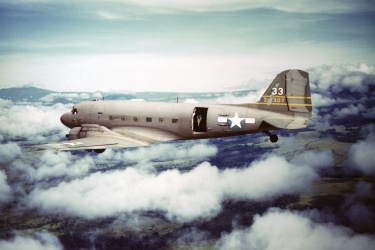 |
The C-47 Skytrain was the militarized version of the legendary Douglas DC-3 airliner and became the mainstay of the US and Allied transport fleets during World War II. They were also memorable as a paratroop transport during the many airborne operations of the war. |
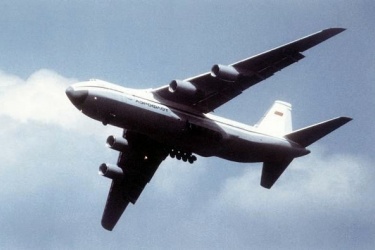 |
The Soviet (now Ukrainian) design bureau of Antonov has been behind some of the largest transport aircraft ever made like the An-124 Ruslan. The even more massive An-225 had six engines but the only example built was destroyed during the Russian invasion of Ukraine. |
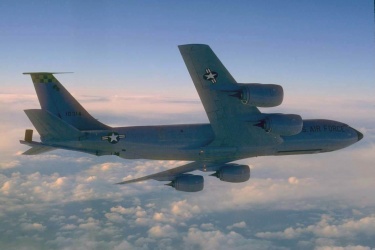 |
The USAF's global power projection would be impossible without its massive fleet of tankers, which is considerably larger than the rest of the world's combined. The main workhorse of this fleet is the Boeing KC-135, based on the 707 airliner. |
Helicopters
Helicopters are classified on this site under the same roles of fixed-wing aircraft. In many cases like observation and utility, these roles are now used almost exclusively by helicopters. The most common helicopter classifications are described below:
Attack (AH): Helicopters proved ideal in the close support role as flying tank-killers. They are large, can survive high caliber machine-gun and cannon fire, and are armed with powerful rotary cannons, rockets, and anti-tank missiles. Examples include the AH-1, AH-64 (US), and Mi-28 (Russia). The fearsome Mi-24 (USSR/Russia) is unique in that it can function as both an attack helicopter as well as an assault transport. The latest versions of the AH-64 and Mi-28 even feature mast-mounted radars which give them even more precision.
Reconnaissance/Attack (RAH): This is the multi-role equivalent of an attack helicopter, which has battlefield reconnaissance and observation also as a primary role. They can often carry the same stand-off weaponry as attack helicopters but may be less well-protected or lack rotary cannon. The most notable example is the Eurocopter Tigre/Tiger (France/Germany). Some are simply attack versions of observation helicopters, like the AH-58D (US).
Utility (UH): These are general purpose helicopters built to perform a variety of support roles such as transport and air ambulance, but can also be used for reconnaissance or attack. The quintessential utility helicopter is the legendary UH-1 (US) which was used as a battlefield taxi during the Vietnam War but could also provide suppressive fire to troops on the ground with machine guns and rockets. More modern variants include the UH-60 (US) and Mi-8 (Russia), which can be configured to carry some of the same weaponry as attack helicopters.
Transport (CH): These are dedicated transports capable of carrying more troops than utility helicopters and some are large enough to carry vehicles. They are typically the largest helicopters in any military, often having tandem rotors like the CH-46/47 (US). The largest helicopter in the world, the Mi-26 (Russia), has a carrying capacity of nearly 20 tons, equivalent to a C-130 Hercules aircraft.
Observation (OH): Helicopters have largely replaced fixed-wing aircraft as battlefield scouts, benefitting from the ability to loiter in the same location, and their improved cockpit visibility that allows them a full field of vision in almost all directions. Modern observation helicopters are equipped with low light level TV sensors or IRST and some have attack capabilities as well as is the case with the Gazelle (France) and OH-1 (Japan).
Special Operations (MH): Similar to their fixed-wing counterparts, these are designed for infiltration and extraction, night-time operations, among other special ops mission.
Anti-Submarine (SH): Most modern warships have provisions for operating helicopters, many of which are specialized for anti-submarine warfare. These helicopters can be equipped with dunking sonars, magnetic anomaly detectors, sonobuoys, and can also be armed with torpedoes or anti-ship missiles, though usually smaller ones than those used by fixed-wing aircraft. Other naval helicopters lack a dedicated ASW role but are still employed for search-and-rescue, reconnaissance, or anti-shipping strike. Examples include the SH-60 (US), Lynx HAS (UK), and NH.90 NFH (France/Germany/Italy).
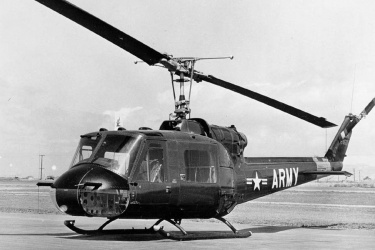 |
The Bell UH-1 Huey was an iconic helicopter that became an enduring symbol of the Vietnam War. It was most famously used as a troop transport, an air ambulance, and could also be used as a gunship. Hundreds continue to serve in armies and air forces around the world. |
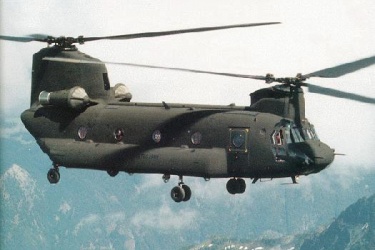 |
The easily recognizable twin-bladed CH-47 Chinook is one of the most widely used transport aircraft in service around the world. From Vietnam to Afghanistan, they have been able to land troops in places that otherwise would be innaccesible and, equally important, able to get them out. |
.jpg) |
The Franco-German Eurocopter Tiger (or Tigre) may not be a 'pure' attack helicopter like the AH-64 Apache but it can do almost everything the Apache can do in addition to performing other roles such as reconnaissance and observation. |
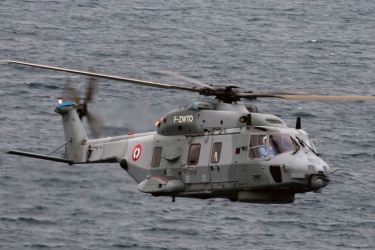 |
The NH 90 is a Franco-German-Italian helicopter that is used for many roles including anti-submarine warfare (ASW). With their sophisticated sensors, ASW helicopters have greatly expanded the sub-hunting capabilities of smaller ships like frigates and destroyers. |
Unmanned
Unmanned Aerial Vehicle (UAVs), or drones, may one day be able to perform all the roles that fixed-winged aircraft do, but for the moment they are limited to just a few:
Multi-Role (MQ): Most drones are currently classified as multi-role, with reconnaissance and close support being the main types of missions that they undertake. Drones benefit from very long endurance times and high service ceilings which are ideal for battlefield surveillance. Most can also carry precision munitions and missiles which can be guided by laser designators. Examples of multi-role drones are the MQ-1, and MQ-9 (US).
Reconnaissance (RQ): The endurance and high service ceilings of drones make them ideal as strategic reconnaissance and surveillance platforms. They are usually larger than multi-role drones (around the size of a tactical aircraft) and can carry highly sophisticated radar and electro-optical equipment. The RQ-4 (US) is the best well known drone of this type currently in service.
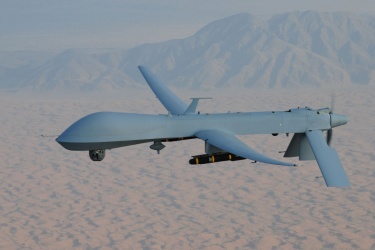 |
The MQ-1 Predator was arguably the first UAV to achieve widespread recognition, and notoriety, during the so-called War on Terror. Smaller UAVs like the Turkish Bayraktar TB2 have proven to be nearly as effective and considerably cheaper. |
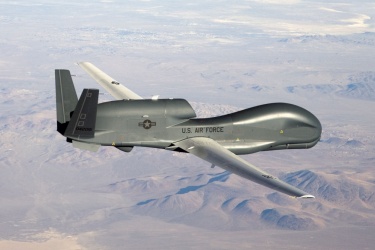 |
The RQ-4 Global hawk is a huge UAV that is used for surveillance and reconnaisse duties. The longer endurance of UAVs compared to manned aircraft give an advantage to these platforms in these roles. . |